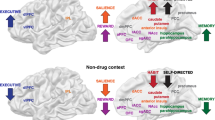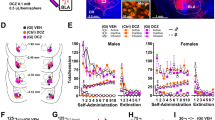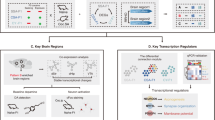Abstract
Humans with drug addiction exhibit compulsive drug-seeking associated with impairment of prefrontal cortex cognitive function. Whether prefrontal cortex dysfunction is a consequence of chronic drug exposure, or mediates the transition from drug use to drug dependence, is unknown. The current study investigates whether a history of escalated vs controlled cocaine intake is associated with specific working memory impairments, and long-lasting alterations of the dorsomedial prefrontal cortex and orbitofrontal cortex in rats. Working memory was assessed in rats with a history of extended (6 h per session) or limited (1 h per session) access to cocaine (0.5 mg/kg per injection), 3–17 days after the last self-administration session, using a delayed nonmatching-to-sample task. The density of neurons, oligodendrocytes, and astrocytes was quantified in the dorsomedial prefrontal cortex and orbitofrontal prefrontal cortex 2 months after the last self-administration session. Working memory impairments were observed after a history of chronic and escalated cocaine intake, but not after repeated limited access to cocaine. Moreover, working memory impairments were correlated with a decreased density of neurons and oligodendrocytes but not astrocytes in the dorsomedial prefrontal cortex, and with a decreased density of oligodendrocytes in the orbitofrontal cortex. Considering the role of the prefrontal cortex in goal-directed behavior, the prefrontal cortex dysfunctions observed here may exacerbate the loss of control associated with increased drug use and facilitate the progression to drug addiction.
Similar content being viewed by others
Log in or create a free account to read this content
Gain free access to this article, as well as selected content from this journal and more on nature.com
or
References
Aggleton JP, Neave N, Nagle S, Sahgal A (1995). A comparison of the effects of medial prefrontal, cingulate cortex, and cingulum bundle lesions on tests of spatial memory: evidence of a double dissociation between frontal and cingulum bundle contributions. J Neurosci 15: 7270–7281.
Ahmed SH, Koob GF (1998). Transition from moderate to excessive drug intake: change in hedonic set point. Science 282: 298–300.
Bechara A (2005). Decision making, impulse control and loss of willpower to resist drugs: a neurocognitive perspective. Nat Neuro 8: 1458–1463.
Ben-Shahar O, Keeley P, Cook M, Brake W, Joyce M, Nyffeler M et al (2007). Changes in levels of D1, D2, or NMDA receptors during withdrawal from brief or extended daily access to IV cocaine. Brain Res 1131: 220–228.
Bowers MS, McFarland K, Lake RW, Peterson YK, Lapish CC, Gregory ML et al (2004). Activator of G protein signaling 3: a gatekeeper of cocaine sensitization and drug seeking. Neuron 42: 269–281.
Brozoski TJ, Brown RM, Rosvold HE, Goldman PS (1979). Cognitive deficit caused by regional depletion of dopamine in prefrontal cortex of rhesus monkey. Science 205: 929–932.
Brush ES, Mishkin M, Rosvold HE (1961). Effects of object preferences and aversions on discrimination learning in monkeys with frontal lesions. J Comp Physiol Psychol 54: 319–325.
Cole JWL, Grizzle JE (1966). Applications of multivariate analysis to repeated measures experiments. Biometrics 22: 810–828.
Crespo JA, Oliva JM, Ghasemzadeh MB, Kalivas PW, Ambrioso E (2002). Neuroadaptive changes in NMDAR1 gene expression after extinction of cocaine self-administration. Ann NY Acad Sci 965: 78–91.
Dalley JW, Laane K, Pena Y, Theobald DE, Everitt BJ, Robbins TW (2005). Attentional and motivational deficits in rats withdrawn from intravenous self-administration of cocaine or heroin. Psychopharmacology (Berl) 182: 579–587.
Dalley JW, Fryer TD, Brichard L, Robinson ESJ, Theobald DEH, Laane K et al (2007). Nucleus accumbens D2/3 receptors predict trait impulsivity and cocaine reinforcement. Science 315: 1267–1270.
Dawson MR, Levine JM, Reynolds R (2000). NG2-expressing cells in the central nervous system: are they oligodendroglial progenitors? J Neurosci Res 61: 471–479.
Delatour B, Gisquet-Verrier P (1996). Prelimbic cortex specific lesions disrupt delayed-variable response tasks in the rat. Behav Neurosci 110: 1282–1298.
Deroche-Gamonet V, Belin D, Piazza PV (2004). Evidence for addiction-like behavior in the rat. Science 305: 1014–1017.
Divac I (1971). Frontal lobe system and spatial reversal in the rat. Neuropsychologia 9: 175–183.
Everitt BJ, Robbins TW (2005). Neural systems of reinforcement for drug addiction: from actions to habits to compulsion. Nat Neuro 8: 1481–1489.
Ferrario CR, Gorny G, Crombag HS, Li Y, Kolb B, Robinson TE (2005). Neural and behavioral plasticity associated with the transition from controlled to escalated cocaine use. Biol Psychiatry 58: 751–759.
Fletcher PJ, Tenn CC, Rizos Z, Lovic V, Kapur S (2005). Sensitization to amphetamine, but not PCP, impairs attentional set shifting: reversal by a D1 receptor agonist injected into the medial prefrontal cortex. Psychopharmacology (Berl) 183: 190–200.
Fletcher PJ, Tenn CC, Sinyard J, Rizos Z, Kapur S (2007). A sensitizing regimen of amphetamine impairs visual attention in the 5-choice serial reaction time test: reversal by a D1 receptor agonist injected into the medial prefrontal cortex. Neuropsychopharmacology 32: 1122–1132.
Franklin TR, Acton PD, Maldjian JA, Gray JD, Croft JR, Dackis CA et al (2002). Decreased gray matter concentration in the insular, orbitofrontal, cingulate, and temporal cortices of cocaine patients. Biol Psychiatry 51: 134–142.
Gabbott PL, Warner TA, Jays PR, Salway P, Busby SJ (2005). Prefrontal cortex in the rat: projections to subcortical autonomic, motor, and limbic centers. J Comp Neurol 492: 145–177.
Gerlai R (1998). A new continuous alternation task in T-maze detects hippocampal dysfunction in mice. A strain comparison and lesion study. Behav Brain Res 95: 91–101.
Gerlai R (2001). Behavioral tests of hippocampal function: simple paradigms complex problems. Behav Brain Res 125: 269–277.
Goldstein RZ, Volkow ND (2002). Drug addiction and its underlying neurobiological basis: neuroimaging evidence for the involvement of the frontal cortex. Am J Psychiatry 159: 1642–1652.
Hester R, Garavan H (2004). Executive dysfunction in cocaine addiction: evidence for discordant frontal, cingulate, and cerebellar activity. J Neurosci 24: 11017–11022.
Homayoun H, Moghaddam B (2007). Fine-tuning of awake prefrontal cortex neurons by clozapine: comparison with haloperidol and N-desmethylclozapine. Biol Psychiatry 61: 679–687.
Jacobsen CC (1936). Studies of cerebral function in primates: I. The functions of the frontal association areas in monkeys. Comp Psychol Monogr 13: 3–60.
Jentsch JD, Taylor JR (1999). Impulsivity resulting from frontostriatal dysfunction in drug abuse: implications for the control of behavior by reward-related stimuli. Psychopharmacology (Berl) 146: 373–390.
Kalivas PW, Volkow ND (2005). The neural basis of addiction: a pathology of motivation and choice. Am J Psychiatry 162: 1403–1413.
Kempermann G, Gast D, Kronenberg G, Yamaguchi M, Gage FH (2003). Early determination and long-term persistence of adult-generated new neurons in the hippocampus of mice. Development 130: 391–399.
King VR, Corwin JV (1992). Spatial deficits and hemispheric asymmetries in the rat following unilateral and bilateral lesions of posterior parietal or medial agranular cortex. Behav Brain Res 50: 53–68.
Kodama M, Fujioka T, Duman RS (2004). Chronic olanzapine or fluoxetine administration increases cell proliferation in hippocampus and prefrontal cortex of adult rat. Biol Psychiatry 56: 570–580 [erratum: 57: 199].
Koob GF, Le Moal M (2005). Plasticity of reward neurocircuitry and the ‘dark side’ of drug addiction. Nat Neuro 8: 1442–1444.
Krawczyk DC, Gazzaley A, D'Esposito M (2007). Reward modulation of prefrontal and visual association cortex during an incentive working memory task. Brain Res 1141: 168–177.
Lalonde R (2002). The neurobiological basis of spontaneous alternation. Neurosci Biobehav Rev 26: 91–104.
Mandyam CD, Norris RD, Eisch AJ (2004). Chronic morphine induces premature mitosis of proliferating cells in the adult mouse subgranular zone. J Neurosci Res 76: 783–794.
Maxwell SE, Delaney HD (1990). Designing Experiments and Analyzing Data: A Model Comparison Perspective. Brooks/Cole: Belmont.
Mishkin M (1964). Perseveration of central sets after frontal lesions in man.In: Warren JM, Akert K (eds). The Frontal Granular Cortex and Behavior. McGraw-Hill: New York, pp 219–294.
Mishkin M, Pribram KH (1956). Analysis of the effects of frontal lesions in monkey: II. Variations of delayed response. J Comp Physiol Psychol 49: 36–40.
Mizoguchi K, Yuzurihara M, Ishige A, Sasaki H, Chui DH, Tabira T (2000). Chronic stress induces impairment of spatial working memory because of prefrontal dopaminergic dysfunction. J Neurosci 20: 1568–1574.
Narayanan NS, Laubach M (2006). Top-down control of motor cortex ensembles by dorsomedial prefrontal cortex. Neuron 52: 921–931.
Nieto-Escamez FA, Sanchez-Santed F, de Bruin JPC (2002). Cholinergic receptor blockade in prefrontal cortex and lesions of the nucleus basalis: implications for allocentric and egocentric spatial memory in rats. Behav Brain Res 134: 93–112.
Nogueira L, Kalivas PW, Lavin A (2006). Long-term neuroadaptations produced by withdrawal from repeated cocaine treatment: role of dopaminergic receptors in modulating cortical excitability. J Neurosci 26: 12308–12313.
Paxinos G, Watson C (1997). The Rat Brain in Stereotaxic Coordinates. Academic Press: San Diego.
Pfefferbaum A, Sullivan EV, Rosenbloom MJ, Mathalon DH, Lim KO (1998). A controlled study of cortical gray matter and ventricular changes in alcoholic men over a 5-year interval. Arch Gen Psychiatry 55: 905–912.
Pribram KH (1961). A further experimental analysis of the behavioral deficit that follows injury to the primate frontal cortex. Exp Neurol 3: 432–466.
Roesch MR, Takahashi Y, Gugsa N, Bissonette GB, Schoenbaum G (2007). Previous cocaine exposure makes rats hypersensitive to both delay and reward magnitude. J Neurosci 27: 245–250.
Rogers RD, Robbins TW (2001). Investigating the neurocognitive deficits associated with chronic drug misuse. Curr Opin Neurobiol 11: 250–257.
Sakurai Y, Sugimoto S (1986). Multiple unit activity of prefrontal cortex and dorsomedial thalamus during delayed go/no-go alternation in the rat. Behav Brain Res 20: 295–301.
Schoenbaum G, Roesch MR, Stalnaker TA (2006). Orbitofrontal cortex, decision-making and drug addiction. Trends Neurosci 29: 116–124.
Schoenbaum G, Saddoris MP, Ramus SJ, Shaham Y, Setlow B (2004). Cocaine-experienced rats exhibit learning deficits in a task sensitive to orbitofrontal cortex lesions. Eur J Neurosci 19: 1997–2002.
Schoenbaum G, Setlow B (2005). Cocaine makes actions insensitive to outcomes but not extinction: implications for altered orbitofrontal-amygdalar function. Cereb Cortex 15: 1162–1169.
Seiwell AP, Reveron ME, Duvauchelle CL (2007). Increased accumbens Cdk5 expression in rats after short-access to self-administered cocaine, but not after long-access sessions. Neurosci Lett 417: 100–105.
Seri B, Garcia-Verdugo JM, McEwen BS, Alvarez-Buylla A (2001). Astrocytes give rise to new neurons in the adult mammalian hippocampus. J Neurosci 21: 7153–7160.
Simon H, Scatton B, Moal ML (1980). Dopaminergic A10 neurones are involved in cognitive functions. Nature 286: 150–151.
Sorg BA, Davidson DL, Kalivas PW, Prasad BM (1997). Repeated daily cocaine alters subsequent cocaine-induced increase of extracellular dopamine in the medial prefrontal cortex. J Pharmacol Exp Ther 281: 54–61.
Stewart CV, Plenz D (2006). Inverted-U profile of dopamine-NMDA-mediated spontaneous avalanche recurrence in superficial layers of rat prefrontal cortex. J Neurosci 26: 8148–8159.
Taylor SF, Welsh RC, Wager TD, Phan KL, Fitzgerald KD, Gehring WJ (2004). A functional neuroimaging study of motivation and executive function. Neuroimage 21: 1045–1054.
Trantham H, Szumlinski KK, McFarland K, Kalivas PW, Lavin A (2002). Repeated cocaine administration alters the electrophysiological properties of prefrontal cortical neurons. Neuroscience 113: 749–753.
Vaccarino FM, Fagel DM, Ganat Y, Maragnoli ME, Ment LR, Ohkubo Y et al (2007). Astroglial cells in development, regeneration, and repair. Neuroscientist 13: 173–185.
Vanderschuren LJ, Everitt BJ (2004). Drug seeking becomes compulsive after prolonged cocaine self-administration. Science 305: 1017–1019.
Walton ME, Bannerman DM, Alterescu K, Rushworth MF (2003). Functional specialization within medial frontal cortex of the anterior cingulate for evaluating effort-related decisions. J Neurosci 23: 6475–6479.
Wee S, Mandyam CD, Lekic DE, Koob GF (2007). Altered alpha1-noradrenergic system is related to increased motivation for cocaine intake in rats with prolonged access. Eur J Neuropsychopharmacol.
Williams JM, Steketee JD (2005). Time-dependent effects of repeated cocaine administration on dopamine transmission in the medial prefrontal cortex. Neuropharmacology 48: 51–61.
Acknowledgements
This is publication number 18690 from The Scripps Research Institute. This work was supported by National Institutes of Health grant DA04398 from the National Institute on Drug Abuse, the Pearson Center for Alcoholism and Addiction Research, and IES Brain Research Foundation. We thank Dr Frederique Ambroggi and Dr Heather Richardson for helpful comments on the manuscript, and the reviewers for their constructive critiques. We also thank Katy Rahmani, Hanan Jammal, Youn Kyung Lee, Stephanie HoChan, and Robert Lintz for their technical assistance and Michael Arends for his editorial assistance.
Author information
Authors and Affiliations
Corresponding author
Additional information
DISCLOSURE/CONFLICT OF INTEREST
The authors declare that, except for income received from the primary employer, no financial support or compensation has been received from any individual or corporate entity over the past 3 years for research or professional service, and there are no personal financial holdings that could be perceived as constituting a potential conflict of interest.
Supplementary Information accompanies the paper on the Neuropsychopharmacology website (http://www.nature.com/npp)
Supplementary information
Rights and permissions
About this article
Cite this article
George, O., Mandyam, C., Wee, S. et al. Extended Access to Cocaine Self-Administration Produces Long-Lasting Prefrontal Cortex-Dependent Working Memory Impairments. Neuropsychopharmacol 33, 2474–2482 (2008). https://doi.org/10.1038/sj.npp.1301626
Received:
Revised:
Accepted:
Published:
Issue date:
DOI: https://doi.org/10.1038/sj.npp.1301626
Keywords
This article is cited by
-
Cocaine’s cerebrovascular vasoconstriction is associated with astrocytic Ca2+ increase in mice
Communications Biology (2022)
-
Ca2+ channel blockade reduces cocaine’s vasoconstriction and neurotoxicity in the prefrontal cortex
Translational Psychiatry (2021)
-
Individual differences in addiction-like behaviors and choice between cocaine versus food in Heterogeneous Stock rats
Psychopharmacology (2021)
-
Cocaine-induced ischemia in prefrontal cortex is associated with escalation of cocaine intake in rodents
Molecular Psychiatry (2020)
-
Risks Versus Consequences of Adolescent and Young Adult Substance Use: a Focus on Executive Control
Current Addiction Reports (2020)



